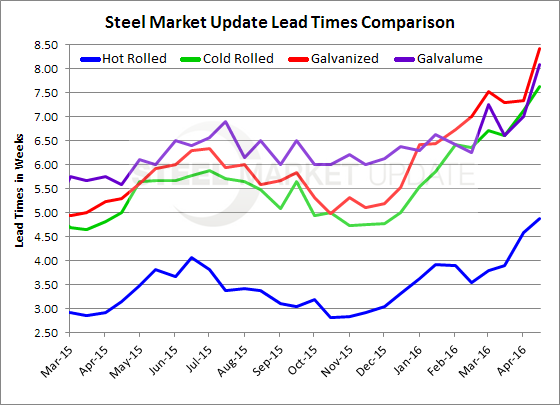SMU Data and Models

Steel Mill Lead Times Now Averaging 1-3 Weeks Longer than One Year Ago
Written by John Packard
April 24, 2016
According to our latest flat rolled steel market survey which was conducted last week, steel mill lead times have continued to move out on every single one of the flat rolled products. The extended mill lead times are one of the primary reasons behind the increases in flat rolled steel prices, pressure on deliveries, allocations existing at certain mills on certain products and the need by many steel buyers to adjust buy schedules in light of the new lead times.
Hot rolled lead times are now being reported as averaging 4.87 weeks. This is an increase of almost one full week compared to one month ago and is almost two weeks longer than what we reported one year ago. HR lead times are now the most extended since the middle of May 2014 when we reported HRC lead times as averaging 4.91 weeks.
Cold rolled, just like hot rolled, is now averaging one week longer than what we reported one month ago and is more than 2.5 weeks longer than one year ago. CR lead times are the most extended since mid-April 2014 when we reported CRC lead times as averaging 7.84 weeks.
Based on our survey results, galvanized lead times are now averaging 8.42 weeks, more than one week longer than one month ago and almost three weeks longer than one year ago. The 8.42 weeks is the most extended lead time we have ever reported based on our survey results.
Galvalume lead times are also extended now being reported as averaging 8.08 weeks, almost 1.5 weeks longer than one month ago and 2.5 weeks longer than one year ago. This is also the longest lead time we have ever reported for Galvalume.
To see an interactive history of our Steel Mill Lead Time data, visit our website here.

John Packard
Read more from John PackardLatest in SMU Data and Models

SMU’s June at a glance
A look at SMU data for the month of June.

SMU Survey: Buyers’ Sentiment rebounds from multi-year low
Both of SMU’s Steel Buyers’ Sentiment Indices edged higher this week. Current Sentiment rebounded from a near five-year low, while Future Sentiment rose to a two-month high

SMU flat-rolled market survey results now available
SMU’s latest steel buyers market survey results are now available on our website to all premium members.

SMU Survey: Sheet lead times pull back after early-June blip, plate holds
Following the uptick seen two weeks ago, lead times eased this week for all four sheet products tracked by SMU, while plate lead times held steady, according to this week’s market survey.

SMU Survey: Pricing power abruptly shifts to steel buyers
The majority of steel buyers responding to our latest market survey say domestic mills are more willing to talk price on sheet and plate products than they were earlier this month. Sheet negotiation rates rebounded across the board compared to early June, while our plate negotiation rate hit a full 100%.

